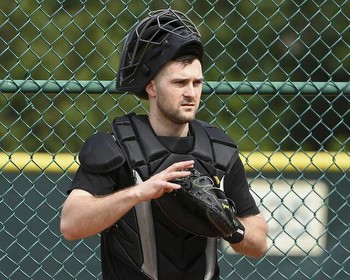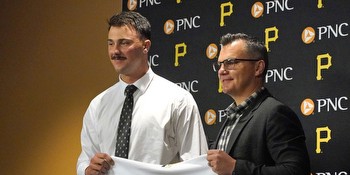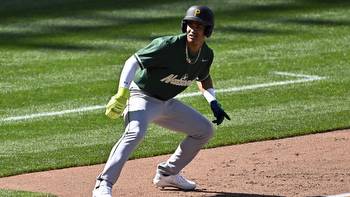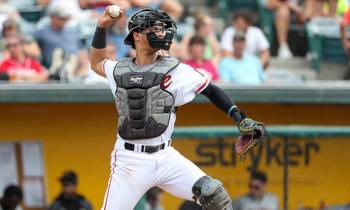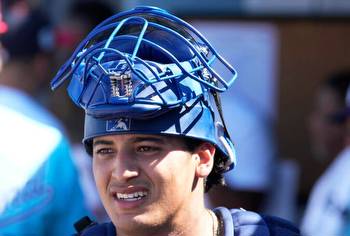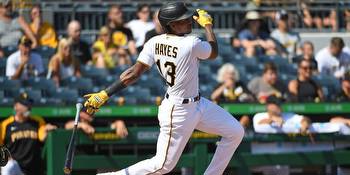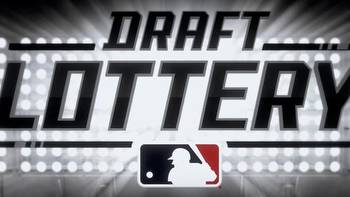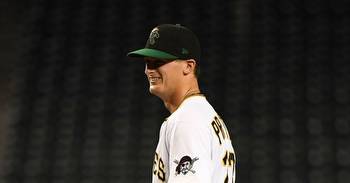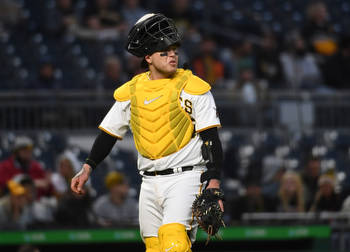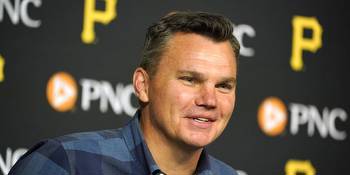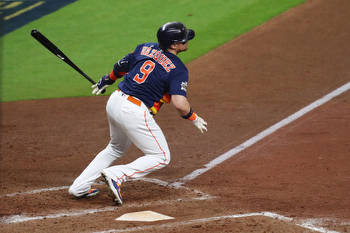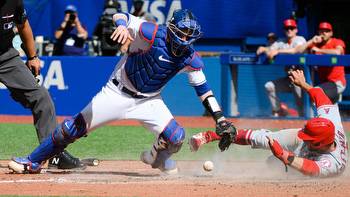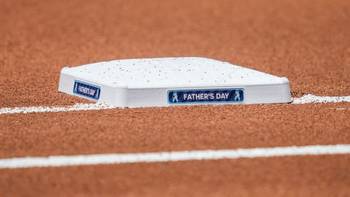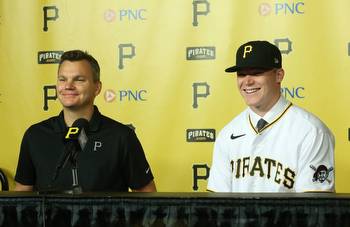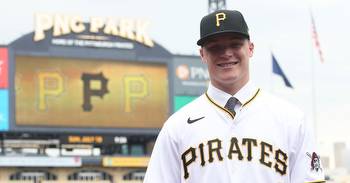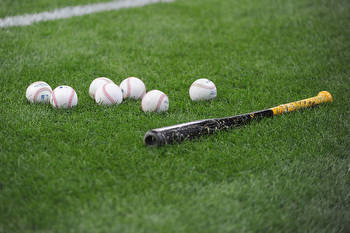Pirates’ catching depth has become a strength and their prospects are primed for next steps
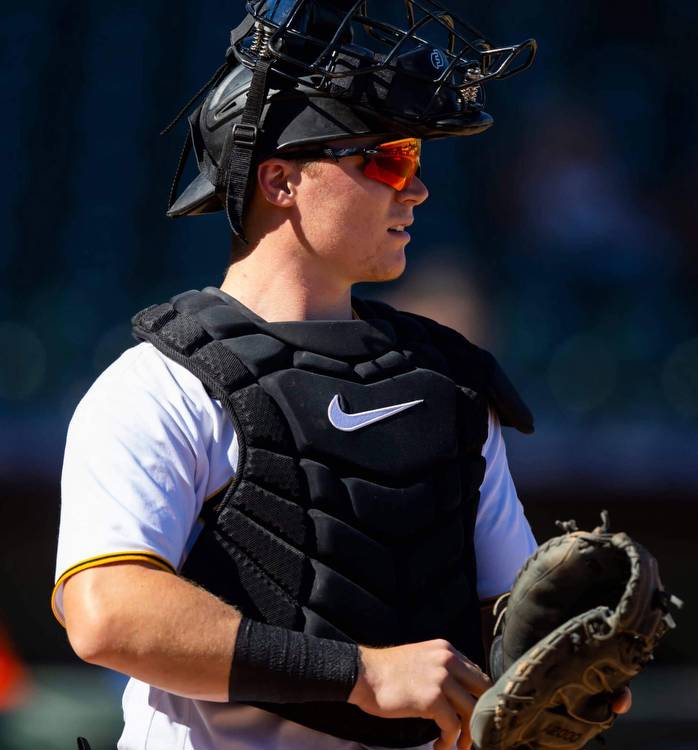
BRADENTON, Fla. — Last Tuesday, when spring training reached its midpoint, the Pirates reassigned catcher Henry Davis to minor-league camp. Even if Davis begins this season at Double A, he likely will get to the top level of the farm system before the summer is over.
Davis, 23, is not far from reaching the majors, and the best part is he’s not even the Pirates’ top catching prospect. That would be 22-year-old Endy Rodriguez, who’s ticketed to open the season with Triple-A Indianapolis and should be in Pittsburgh at some point this year.
“Catching is gold in this industry,” manager Derek Shelton said. “That’s a position we’ve highlighted as important. The fact that we’re starting to get those guys transitioning to upper levels is really important for us.”
When Shelton and general manager Ben Cherington were hired after the 2019 season, the Pirates had practically no catching depth. It was one of the club’s most vexing problems for the better part of the past two decades.
Going into the 2023 season, the situation has turned around. Catching depth is one of the organization’s strengths.
“If you’ve got a good catcher, you’re gonna win,” said Mike LaValliere, who caught for the teams that won the National League East from 1990 to 1992. “I’m proud to have been a Pirates catcher. There were some guys that preceded me, especially Tony (Peña) and Manny (Sanguillen), who were just fabulous.”
From the mid-1970s through the early 2000s, the Pirates enjoyed a run of superb homegrown catchers: Sanguillen, Peña and Jason Kendall. Ryan Doumit, a second-round pick in 1999, was supposed to be next in line, but never panned out.
Lacking viable catching prospects in the early 2010s, the Pirates brought in Russell Martin (free agent) and Francisco Cervelli (trade). That covered the big-league level, but the talent in the minors remained stagnant.
Going into the 2019 season, Baseball America rated Deon Stafford as the Pirates’ No. 22 prospect and tabbed him “the most promising catcher in the system.” He never got any higher than Double A and was released in 2021.
There were no catchers listed on any of the Pirates’ top 30 prospects lists in 2020 or 2021. Jacob Stallings was playing at a Gold Glove Award level in Pittsburgh, but he was a light hitter who was already in his 30s and there was no one in place to succeed him.
After he was hired in November 2019, Cherington might have grimaced when he pulled out the depth charts left by deposed GM Neal Huntington.
“We did not set out to do anything specific with the draft or trades,” Cherington said. “There was no, ‘We’re going to target a catcher.’ We did know it was a position we needed to strengthen over time, so we found ways to do that.”
Cherington restocked the system with seven significant acquisitions. He drafted Davis (first round, 2021), Wyatt Hendrie (seventh round, 2021) and Nick Cimillo (16th round, 2022). Rodriguez, Abrahan Gutierrez and Carter Bins arrived via trades. In January 2022, the Pirates spent $350,000 to sign teenager Axiel Plaz out of Venezuela.
Assembling that group of catchers in only three years is arguably Cherington’s biggest achievement so far, but he won’t take a victory lap unless some of them get to the majors and succeed.
“It definitely feels deeper,” Cherington said. “It’s (part of) a long list of things we need to keep getting better at. We feel good that we’re stronger, but there’s still plenty of development to do. It’s a demanding position and the skills are different than other spots, so it can take time.”
Not all of these prospects are going to click, of course, and it’s too soon to predict their futures. Hendrie hit .248/.346/.360 last year with Low-A Bradenton, his first stint with a full-season affiliate. Cimillo appeared in only eight games with Bradenton and four in the Florida Complex League. Scouts say Gutierrez and Bins are good defensively but probably won’t hit enough to be big-league starters.
Rodriguez and Davis are consensus top-five prospects in the Pirates’ system. The Athletic’s Keith Law ranks Davis at No. 2 and Rodriguez No. 3. Baseball America puts Rodriguez atop its list with Davis No. 3. FanGraphs has Rodriguez No. 2 and Davis No. 3. Plaz, who hit .382 with a 1.206 OPS as a 17-year-old in the Dominican Summer League, also has appeared on several top-30 lists.
“The second a prospect ranking helps the Pirates win a game, I’ll care about it,” Davis said with a grin. “We’re thankful for it, but it doesn’t help us win.”
That’s an argument espoused by the “parades > prospects” crowd, and it’s not wrong. Production, not predictions, wins games. But for the Pirates, whose catching prospects have been neither well-regarded nor prolific for so long, any glimmer of hope will do.
Over the winter, the Pirates gave Austin Hedges a $5 million contract to be their everyday catcher and the bridge to a future in which Rodriguez and Davis run the show. Hedges, 30, is a glove-first catcher with an outgoing personality and an ability to connect with anyone in the clubhouse.
Last year, he was one of a handful of veterans with the Guardians, a plucky, talented bunch that fast-tracked to a playoff berth. When he reported for spring training last month, Hedges knew the Pirates needed him to mentor their young catchers.
“One of the differences here is I’m coming into an organization with real catching depth,” Hedges said. “I’ve had to raise the bar of what I talk to them about because their foundation is already so high. I’m (focusing) on the details I’ve learned through a lot of failure and some success in the big leagues. If I can pass on to 22-year-old guys some wisdom I didn’t learn until I was 30, that will put them ahead of the curve.”
When he broke into the majors with the Padres, Hedges learned from teammates John Baker (who now is the Pirates’ farm director), Nick Hundley and Yasmani Grandal. They gave him pointers about how to dig a curveball out of the dirt, which brand of equipment suits your catching style, how to prepare and how to work out.
“It was so professional and it also was so weird because it’s like, ‘I’m trying to take your job, right?’” Hedges said. “Henry and Endy should be trying to take my job. But that’s not really how it is.”
There’s a sense of fraternity among ballplayers when it comes to moving the game forward. The bond is especially tight with catchers. That’s why Rodriguez and Davis can be found most days plopped down in the semi-circle of chairs around Hedge’s locker.
“For sure, a catcher needs to be a leader,” Rodriguez said. “I like (Hedges). He’s really smooth and there is a lot I can learn from him.”
It’s interesting to watch Rodriguez work the clubhouse each morning in camp. He spends time swapping notes with Hedges and the other catchers, and checks in with the pitchers.
Rodriguez doesn’t stop there, even though he has several meetings and workouts — in the batting cage, catching drills and some side work in the infield and outfield — on his schedule. He works his way around the room, chatting and joking with the non-roster invitees, the veterans and the coaches who’ll occasionally stick their heads in the room.
“He goes about his business like a pro,” Hedges said. “It’s a rare thing for young guys to be confident enough in themselves to have a smile on their face every day, no matter how it’s going. It’s too easy to mess up, too easy to get selfish or take things too seriously. But he’s done a really good job.”
Davis has made an impression with his dogged work ethic. He comes across as being quieter and less emotive than Rodriguez.
“He’s a unique guy and he cares,” Hedges said. “I think I need to convince him to care a little bit less because sometimes he cares too much. When you do, it can consume you and cause anxiety.”
Hedges paused, then clarified what he meant: It’s not that Davis needs to be nonchalant; he has to learn how to focus his intensity when he’s working with the pitching staff.
“You want to get to the point where it’s actually relieving anxiety,” Hedges said. “I want to be a good teammate because the more I care about (the pitcher), the less I’m obsessing about how I’m doing. But you (don’t want to) get too empathetic, where you start to feel (the pitcher’s) insecurity and don’t know what to do with it. There’s a fine line doing that and it can be difficult, especially for a young guy.”
When the Pirates break camp and the catching prospects head to the minors, the process will continue in different ways. Cherington and the development staff must sort out assignments and playing time.
“It starts with how much should they be behind the plate, given where they are age-wise, what they’re working on,” Cherington said. “It’s a demanding position.”
What else does management need to see during the sorting out process?
“We’re trying to prioritize, ‘What’s the defensive skill we’re trying to turn up now and what can we wait on? Offensively, the same thing,” Cherington said. “You’ve got not only the technical skills of catching, but game prep, the relationship with pitchers. We consider catchers part of our pitching coach group because they’re included in all the same meetings as our pitchers. So they’ve got a lot on their plate.”
(Top photo of Endy Rodriguez, Carter Bins, Henry Davis and Kevin Plawecki watching Austin Hedges catch batting practice: Courtesy of the Pittsburgh Pirates)
